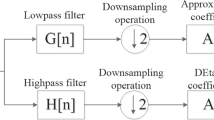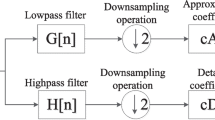Abstract
A local color image watermarking scheme using adaptive segmentation-based feature extraction (ASFE) and singular value decomposition-based spread transform dither modulation (S-STDM) is proposed in this paper. The proposed ASFE can adaptively extract feature regions from blocks segmented by the simple linear iterative clustering. In addition, the stationary wavelet transform is employed to decompose each of the extracted feature regions because of its shift invariance. Consequently, the novel S-STDM watermarking method is proposed, where we employ singular value decomposition to calculate the approximation coefficients and then select the generated diagonal elements from the decomposed diagonal matrix for watermark message embedding. The experimental results show that the proposed scheme is superior to the existing schemes under various attacks.













Similar content being viewed by others
References
Islam M, Roy A, Laskar RH (2018) SVM-based robust image watermarking technique in LWT domain using different sub-bands. Neural Comput Appl. https://doi.org/10.1007/s00521-018-3647-2
Pereira S, Pun T (2000) Robust template matching for affine resistant image watermarks. Trans Image Process 9(6):1123–1129. https://doi.org/10.1109/83.846253
Soliman MM, Hassanien AE, Onsi HM (2016) An adaptive watermarking approach based on weighted quantum particle swarm optimization. Neural Comput Appl 27(2):469–481. https://doi.org/10.1007/s00521-015-1868-1
Zhang F, Zhang X, Shang D (2012) Digital watermarking algorithm based on Kalman filtering and image fusion. Neural Comput Appl 21(6):1149–1157. https://doi.org/10.1007/s00521-011-0656-9
Srivastava R, Kumar B, Singh AK, Mohan A (2018) Computationally efficient joint imperceptible image watermarking and JPEG compression: a green computing approach. Multimed Tools Appl 77(13):16447–16459
Yuan X-C, Pun C-M, Chen CLP (2013) Geometric invariant watermarking by local Zernike moments of binary image patches. Signal Process 93(7):2087–2095. https://doi.org/10.1016/j.sigpro.2013.01.024
Wang C, Wang X, Zhang C, Xia Z (2017) Geometric correction based color image watermarking using fuzzy least squares support vector machine and Bessel K form distribution. Signal Process 134:197–208. https://doi.org/10.1016/j.sigpro.2016.12.010
Zhao J, Zhang N, Jia J, Wang H (2015) Digital watermarking algorithm based on scale-invariant feature regions in non-subsampled contourlet transform domain. J Syst Eng Electron 26(6):1309–1314. https://doi.org/10.1109/JSEE.2015.00143
Wang X, Liu Y, Han M, Yang H (2016) Local quaternion PHT based robust color image watermarking algorithm. J Vis Commun Image Represent 38:678–694
Singh AK, Kumar B, Singh SK, Ghrera S, Mohan A (2018) Multiple watermarking technique for securing online social network contents using back propagation neural network. Future Gener Comput Syst 86:926–939
Singh A (2019) Robust and distortion control dual watermarking in LWT domain using DCT and error correction code for color medical image. Multimed Tools Appl. https://doi.org/10.1007/s11042-018-7115-x
Yuan X-C, Li M (2018) Local multi-watermarking method based on robust and adaptive feature extraction. Signal Process 149:103–117
Thakur S, Singh A, Ghrera S (2018) NSCT domain-based secure multiple-watermarking technique through lightweight encryption for medical images. Concurr Comput Pract Exp. https://doi.org/10.1002/cpe.5108
Tsai J-S, Huang W-B, Kuo Y-H, Horng M-F (2012) Joint robustness and security enhancement for feature-based image watermarking using invariant feature regions. Signal Process 92(6):1431–1445
Wang X, Niu P, Yang H, Wang C, Wang A (2014) A new robust color image watermarking using local quaternion exponent moments. Inf Sci 277:731–754
Agarwal N, Singh AK, Singh PK (2019) Survey of robust and imperceptible watermarking. Multimed Tools Appl 78(7):8603–8633
Lowe DG (2004) Distinctive image features from scale-invariant keypoints. Int J Comput Vis 60(60):91–110
Lazebnik S, Schmid C, Ponce J (2005) A sparse texture representation using local affine regions. IEEE Trans Pattern Anal Mach Intell 27(8):1265–1278
Bay H, Tuytelaars T, Van Gool L (2006) SURF: speeded up robust features. In: Leonardis A, Bischof H, Pinz A (eds) Computer vision – ECCV 2006. Lecture notes in computer science, vol 3951. Springer, Berlin, Heidelberg
Felzenszwalb PF, Huttenlocher DP (2004) Efficient graph-based image segmentation. Int J Comput Vis 59(2):167–181
Achanta R, Shaji A, Smith K, Lucchi A, Fua P, SüSstrunk S (2012) SLIC superpixels compared to state-of-the-art superpixel methods. IEEE Trans Pattern Anal Mach Intell 34(11):2274–2282
Chen B, Wornell GW (1999) Provably robust digital watermarking, In: Tescher AG, Vasudev B, Bove VM, Derryberry B (eds) Multimedia systems and applications II, vol 3845. Boston, MA, United States, pp 43–54
Muhammad N, Bibi N, Qasim I, Jahangir A, Mahmood Z (2018) Digital watermarking using Hall property image decomposition method. Pattern Anal Appl 21(4):997–1012
Bibi N, Farwa S, Muhammad N, Jahngir A, Usman M (2018) A novel encryption scheme for high-contrast image data in the Fresnelet domain. PLoS ONE 13(4):e0194343
Wan W, Liu J, Sun J, Ge C, Nie X, Gao D (2015) Improved spread transform dither modulation based on robust perceptual just noticeable distortion model. J Electron Imaging 24(2):023002
Farwa S, Muhammad N, Shah T, Ahmad S (2017) A novel image encryption based on algebraic S-box and Arnold transform. 3D Res 8(3):26
Wan W, Liu J, Sun J, Ge C, Nie X (2015) Logarithmic STDM watermarking using visual saliency-based JND model. Electron Lett 51(10):758–760
Muhammad N, Bibi N, Mahmood Z, Kim D-G (2015) Blind data hiding technique using the Fresnelet transform. SpringerPlus 4(1):832
Muhammad N, Bibi N (2015) Digital image watermarking using partial pivoting lower and upper triangular decomposition into the wavelet domain. IET Image Proc 9(9):795–803
Bitar AW, Darazi R, Couchot J-F, Couturier R (2017) Blind digital watermarking in PDF documents using spread transform dither modulation. Multimed Tools Appl 76(1):143–161
Farwa S, Shah T, Muhammad N, Bibi N, Jahangir A, Arshad S (2017) An image encryption technique based on chaotic S-box and Arnold transform. Int J Adv Comput Sci Appl 8(6):360364
Muhammad N, Bibi N, Mahmood Z, Akram T, Naqvi SR (2017) Reversible integer wavelet transform for blind image hiding method. PLoS ONE 12(5):e0176979
Haralick RM, Shanmugam K (1973) Textural features for image classification. IEEE Trans Syst Man Cybern 6:610–621
Azad R, Shayegh HR (2014) Novel and tuneable method for skin detection based on hybrid color space and color statistical features. arXiv:14076506
Hsu R-L, Abdel-Mottaleb M, Jain AK (2002) Face detection in color images. IEEE Trans Pattern Anal Mach Intell 24(5):696–706
Nason GP, Silverman BW (1995) The stationary wavelet transform and some statistical applications. In: Antoniadis A, Oppenheim G (eds) Wavelets and statistics. Lecture notes in statistics, vol 103. Springer, New York
The standard color images from the Computer Vision Group at the University of Granada. http://decsai.ugr.es/cvg/dbimagenes. Accessed 2 Feb 2018
Parthasarathy AK, Kak S (2007) An improved method of content based image watermarking. IEEE Trans Broadcast 53(2):468–479
Lin C (2007) Face detection in complicated backgrounds and different illumination conditions by using YCbCr color space and neural network. Pattern Recogn Lett 28(16):2190–2200
Wang X, Liu Y, Li S, Yang H, Niu P (2016) Robust image watermarking approach using polar harmonic transforms based geometric correction. Neurocomputing 174:627–642
Hua C-H, Tu NA, Hur T, Bang J, Kim D, Amin MB, Kang BH, Seung H, Lee S (2018) Selective bit embedding scheme for robust blind color image watermarking. Inf Sci 426:1–18
Acknowledgements
This work was supported by the Faculty Research Grants of the Macau University of Science and Technology (Grant No. FRG-17-003-FI) and the Science and Technology Development Fund of Macau SAR (Grant No. 051/2016/A2).
Author information
Authors and Affiliations
Corresponding author
Ethics declarations
Conflict of interest
The authors declare that there is no conflict of interests regarding the publication of this paper.
Additional information
Publisher's Note
Springer Nature remains neutral with regard to jurisdictional claims in published maps and institutional affiliations.
Rights and permissions
About this article
Cite this article
Li, M., Yuan, X. Adaptive segmentation-based feature extraction and S-STDM watermarking method for color image. Neural Comput & Applic 32, 9181–9200 (2020). https://doi.org/10.1007/s00521-019-04428-x
Received:
Accepted:
Published:
Issue Date:
DOI: https://doi.org/10.1007/s00521-019-04428-x




